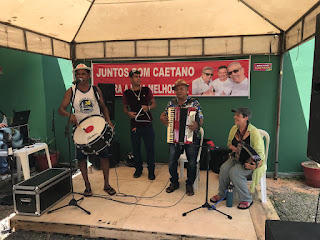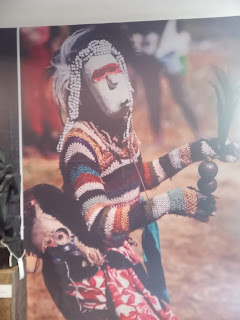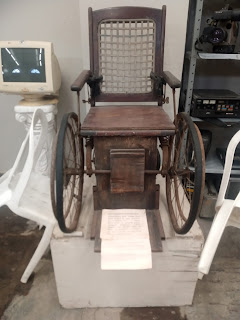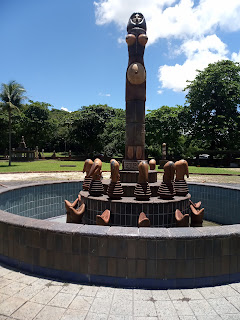On the way to Amazonia!!! and a bit of philosophy
This
entry was started in Salvador on my last days of my three months in and around
there, finished in Recife where I spent a few days staying with a
lovely Couchsurfer, on the first leg of a 5000 km coach and boat trip to Manaus
in Brazilian Amazonia, and finally published from Fortaleza on the north coast of Brazil....
......
Serendipity and Living the Moment
Last time I sat down to write this, last week, I was reflecting about the importance of wandering with no special purpose....
As I wrote then....
“I've just been reading, here in my airbnb in Salvador, a beautiful photo album book by Pierre Verger, a French anthropologist who's done substantial work charting the African diaspora in Brazil. There are several exhibition centres here in Salvador dedicated to his work and showing his photos. The first sentence in the book was about how LOOKING is important, and that he takes photos, not at first understanding why he's taking them; the meaning of the photo becomes clearer to him later. (Many apologies for not writing out the quote specifically)
I didn't
quite know why I was coming to Brazil, but someone in my Amazon study group
said I didn't need to worry, my 'project' would become clear to me. And I just
kind of knew that I had to come here!
So a few
weeks back I asked on the telegram group of people who came on the Digital
Nomad trip to Brazil if anyone wanted to do a 'commitment buddy checkin'
session - where we could review our purpose and our goals with a partner. A young Portuguese digital nomad said she'd love to do that -
we'd had difficulties getting a date, but eventually got together on Monday. It was great hearing all her goals - but what was interesting for me was what came up when it was my turn, was that I'm learning to let the world provide my
experiences each day, that I'm learning to live the joy of a completely empty
diary. And that's what I want to learn from this, and to take home with
me.
This is a
completely new experience for me. I have always been really busy. I think since
I went home during my first term at Bath University when I was 20 having not slept for two weeks and feeling
pretty suicidal, and my mum said 'well, I keep really busy, and it stops me
thinking too much', I have carefully kept a full diary, taken on lots of
commitments, and been very engaged with lots of things. And in the UK I
would sometimes panic if I had an empty day.
But since
I left the language school a month ago I haven't had any commitments, and each
day the world has provided its new thing.... I've looked up something to
do, I've reached out to Couchsurfers or other people I know, I've gone out to a
show or a gallery or something, and I've been playing Forro music (!!!! see
below) I feel I've had a really full experience, completely different to my UK
life where I also have a full experience, but it's always been set up weeks or
months in advance.
One thing
I’ve found while I've been here is that I know absolutely nothing about African
life in Brazil, and I've been reading and learning about this as much as I can
- though there's an enormous amount to learn. I went to the last day of
an art exhibition on Sunday about this. It was called 'Um Defeito de Cor' and
was at the Museu Nacional da Cultura Afro-Brasileira (Muncab). Um Defeito
de Cor means 'A Colour Defect' and I have just found out that the expression
was "the name of an old law that allowed Negroes or mulattos to request
that "the color defect be overlooked" when they demonstrated extreme
talent, competence or will". Wow. And it comes from an internationally acclaimed
novel by Ana Maria Gonçales, that I've just downloaded onto my Kobo (in
Portuguese sadly which makes the reading go MUCH slower).
Finding
out about the title just now was just one more thing that I didn't know about
when I was at the museum: I spent the whole time thinking that I needed the
artists standing next to me, telling me the background to each of the
exhibition pieces. There were textiles, photos, found objects, works related to
the Orixas, videos, and so much more on two levels. I took some photos but like
I said, I needed a guided tour, or long conversations with the artists. There
didn't seem to be a guidebook about this show, except for the novel, so I will
definitely have a go at reading it. I've worked out how to get my screen
reader to read in Portuguese, and it's a lot easier to understand if I'm
hearing it out loud too. Here are the very few pieces that I
photographed:
I also
photographed lots of the labels (in Portuguese), to study at my
leisure....
So as I
think I've said before, all I'm learning is that the older I get, the less I
discover I know. Last year I did a Kings College London Masters
module called 'Language and Global Identity' as a response to realising that
indigenous people's ideas cannot be easily expressed in the languages of
the colonisers. I found it absolutely fascinating (though hard work for the 12
weeks!)....if you have nothing better to do you can read the essay (and
the associated poem!) that I wrote on the course, on my linktree. - they were both published, in the end, after a
bit of tweaking, in the journal of the International EcoLinguistics
Association, a journal, an association, and even a FIELD, that I hadn't even
heard of before I did the course. And now I'm vaguely thinking of
maybe doing another module next year to really push my reading and thinking;
it's called 'Connecting
Cultures, Migration and Immigration, approaches the topic through literature and art,
and gives a chance for individual research on a particular site.... "
Update, Recife.
Continuing my writing from last week in Salvador.... ‘Um
Defeito do Cor’, may be in Portuguese, but a) she writes really clearly and b) I
hate to admit this but I’ve just discovered the Google Translate app, where you
can take a picture of your Kobo screen in Portuguese and it translates it into
English like a little dream. Also c)
when I do have a go at reading it in Portuguese, which really pays off, it
turns out my Kobo has an inbuilt Portuguese/English dictionary!
And the
book begins with an incredible introduction, that I would commend to EVERYONE,
about synchronicity and serendipity – where the author tells a story about being in exactly the right place at exactly the right time in an
almost unbelievable set of circumstances, giving her the potential, the
confidence, and an underpinning narrative to use to write this imagined
novel. She quotes Joseph Henry saying: “The
seeds of great discoveries are constantly floating around us, but they only
take root in minds well-prepared to receive them”. I’m LOVING these constant reminders to walk
around with an open mind free of distractions, (but with my existing knowledge and interests floating around) and I’m absolutely trying to
live like this.
A quote from the blog
of my former neighbour Rebecca Ellis that arrived today came at this from a
different angle. Thinking about her own work in yoga and body movement, she
quotes Jiddu Krishnamurti talking about “Freedom from the Known” and Merlin
Sheldrake who draws attention to “the
gulf between what we expect to find, and what we find when we actually look”. It
seems that I’ve had to travel a long way to find who I want to be when I go
home. Which takes me, of course, to Paulo
Coelho, who made a fortune from retelling the story about having to travel a long way to find what was just under your nose... “Maybe the journey isn’t so much
about becoming anything. Maybe it’s about un-becoming everything that isn’t
really you, so you can be who you were meant to be in the first place.”
It’s now
Sunday (Mothers’ Day/Mothering Sunday 10th March, for the record). I left Salvador on
Wednesday, and I’m spending a few days here in Recife ... where we can't go and swim in the sea, by the way, because of the SHARKS.
So, on my
first morning I went to visit the Jewish museum in the old city. It’s in a street currently called ‘Rua de Bom
Jesus’ – but it definitely had been called Rua dos Judeus in the past. It’s the
first synagogue in the whole of South America and there’s a fascinating story
of Jews from Spain and Portugal fleeing the Inquisition, being accepted by the
Dutch, and then being persecuted again by the Portuguese, so they had to escape
to the interior of Brazil, leave the country (around 23 of them went to New
York, or New Amsterdam at the time, in 1650, and helped to build the new city)
or hide their Jewish practices. Those
who chose to hide their identity, or to convert, lived as ‘New Christians’ but
often kept various Jewish practices in secret, and many of their descendants
have returned to Judaism.
I then
whizzed off to the other side of town to see a museum that had looked really
interesting when I looked up what Recife had to offer – the Museum of Abolition. I ignored the negative
reviews but in fact, there wasn’t any information specifically about abolition up in the
museum – they are revamping their permanent exhibition with no opening date in
site. There were three temporary
exhibitions, one of which, on the photography of resistance, with photos
hanging in trees – making me think of lynchings of course – I felt was particularly
powerful.
At the
time I only had one more day planned in Recife, I’d already been invited out to
Olinda the following afternoon, and many of the museums weren’t open on
Saturday mornings. So I whizzed back to
the old city in an Uber, and went to the Rolando Toro Afro Brazilian Art
Museum museum, which I’d noticed on the
map when I was looking for the Museum of Abolition.
And found
utterly the perfect material for a case study for if I do the Masters module I
talked about ....
My hostess invited me to stay for two extra days in Recife, so more later, but for now, return to Salvador and a bit of a musical digression...
Forro (pronounced Fo’ Ho’)
I wrote in my last blog that I was going to spend a day with THIS GUY to learn Forro rhythms.
Well I did, I went an hour up
the coast to Camacari with a friend from the language school, and while I learned melodeon
riffs she learned the triangle..
And as I
wrote in my facebook page on the day, ‘Well , one of the things I was hoping
for when I set off was to be in a street band for carnival . Well that didn’t
happen .BUT I’ve just spent the day learning to play Forro riffs on the
melodeon ... and now I’m in the band for the next two Sundays!!! “
The following Sunday when I went back to 'be in the band', there was no sign of Luiz, and instead I spent an hour at lunchtime playing with THIS guy, Chiquinho, who you’ll see plays accordion, not melodeon (or as they say here, samfona) ie with 80 bases instead of 8 bases).
He's bloody brilliant and once I'd trained him that I could only accompany him if he stuck to G or D keys, we got on really well musically.
It was a birthday party, there were six bands, and we were the last to go on – it was fine apart from when our singer started singing, at which point I stopped being able to hear the tune!
The
second Sunday was a political rally, with free beer and food and lots of
speeches in between the tunes. I played
for the first hour and then gave up my place to another accordion player who
actually knew the tunes properly, but I had had a VERY nice time
– I went with Josh, another student from the language school, who acted as photographer (and beer taster!)
And now
I’ve been invited back to be in the band during the Sao Joao festivities in
June.... I’m not sure if that’s going to work out with my travel plan now. We
will see!
---
Just
before I left Salvador I went off to Cachoeira for a couple of nights. It’s a
beautiful little town two and a half hours away from Salvador, which has very
strong candomble traditions and a quilombola community nearby. It has a big
artistic community.... and I would have known none of this if I hadn’t put a
quick question on a Brazil Travel community facebook group a few days before I
set off, and Sayuri answered and put me in touch with a friend of hers. Sayuri is a fab guide who took Jen and me and
a few of the Digital Nomads I arrived in Brazil with, on an Afro Brazil tour of
Pelourinho in December. Her friend is an
artist in Cachoeira and doesn't really do guiding any more, but he was happy to take me round: he
met me from the bus and took me to my (beautiful) pousada (in the old
convent)... he introduced me to Terreiros and Artists and Galleries and Cafes
(an extraordinary amount of which seemed to be showing his art), he introduced
me to a lovely hairdresser for a really good £2.50 dry haircut...
And I just wanted to say what an amazingly good idea it was to have a local person when you arrive in a strange town. If it hadn’t been for him I’d presumably have hung out in some coffee shops and gone to a few museums – this way was so much richer.
And THAT is why I chose to stay
with someone from the wonderful international Couchsurfing community in Recife
(and why I’ll be staying with someone from another international hosting
community, SERVAS, in Fortaleza).... yes you give up a bit of independence, but if you’re lucky (and I absolutely was
this week) you get to make a new friend and spend real time in a city with a
local who will suggest where you ought to go, and might even go with you to
some of the places – as the wonderful Christianne actually did. Here we are together in Olinda with the gorgeous
view of the bay behind us.
I’ve been
putting the finishing touches to this newsletter in the restaurant of the Francisco
Brennand Ceramic Institute, another place
Christianne recommended. It’s the strangest
place – a sprawling sculpture park and garden,
with seven or eight enormous buildings, and two or three formal courtyards, most
of which are dedicated to the very distinctive sculpture and tile art of
Francisco Brennand, and two spaces dedicated to looking at the origins of the
space the park is using. One of these
includes interviews, information panels and art works relating to other communities – Indigenous, Quilombola – which had been based at the site before the Brennand
family owned it... and the other is currently dedicated to an enormous
installation of a cobra, by Ernesto Neto, called CapiDançaBaribéNois.
Reminding me of shedboatshed, by Simon Starling in 2005 when he
dismantled a shed, turned it into a boat to transport it a few miles downstream
and then turned it back into a shed, this 47 metre long tubular crocheted
sculpture was ceremonially
danced along the Capibaribe river as part of its installation ceremony.... the
snake itself was surrounded by hanging drums (I couldn’t resist the urge to
beat one, with the sticks left temptingly on the top of the skin - I only realised later that there WAS a
curator in the otherwise deserted building, but maybe the viewer is actually
meant to participate by drumming? Certainly they didn’t run to stop me.... )...
the building itself was decorated with
more wall art inside and out, relating to the environment and the local animal
and bird life.
And the
restaurant was the first place I’ve been to in the whole of Brazil where not
only the manager but also the waiter told me that yes, they knew I’d ordered
such and such, but the chef has made this absolutely delicious fish dish, and
would I like that instead... and same again, suggesting that rather than
whatever I’d ordered I would actually prefer the highly recommended banana and
cheese (!) pudding. Which were indeed
both delicious. HIGHLY recommended - I think the best meal I've eaten in Brazil so far.
The local
Jewish community took me in, as they had in Salvador (you can travel thousands
of miles, but still feel like you’re with family in a Shabbat service....).
Next leg,
a 14 hour bus trip to Fortaleza
A 20 hour
bus trip to Sao Luis
And then
down to Brazilian Amazonia (buses to Altamira and Santarem, and a 3 or 4 day boat
to Manaus). Amazonia starts with the
city of Belem, which is to be the host of COP30 next year. I’m very interested to see what that place
feels like, having hung out at COP26 in Glasgow .
Please
join my whatsapp group to get day by day updates, the link is here.... https://chat.whatsapp.com/IAilrufbWa91GyEIDBrE6x
and to finish, here's me on the bowsprit of a little day out to the island of Frades just before I left Salvador, with a lovely Couchsurfer Anisio who took the pic
lots of love
Fiona
















































































.JPEG)


Comments
Post a Comment